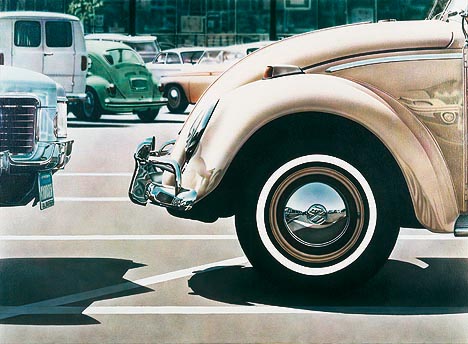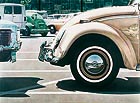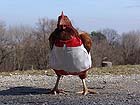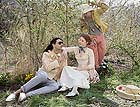
translated and summarized by: Liz Wollner-Grandville,
English summary May 4 - 10
Deutsche Guggenheim Berlin: Picturing America: Photorealism of the 70s
Dead end
Photorealism was an insult, a punch in the face of all those – artists and critics – who simply wanted to continue writing art history. Not only did photorealism attempt to resurrect a genre, it also utilized the obsolete principle of mimesis, devoted itself completely to figurative art. But the biggest impertinence in this double regression was the blatant usage of photography as a source – a measure already applied in the old days of the camera obscura, but always secretly, as a painter had to ensure that he presents his genuine geniality. Dim-witted copying was not tolerated, at least not by the guardians of high art, even if collectors purchased these works with great enthusiasm (probably one of the reasons why the MUMOK, the Ludwig Foundation, is so strongly represented here).
But from today’s perspective, and in view of this exhibition with the largest overview in Germany for the past 30 years, one can say: the guardians were right. Photorealism was not the main path or a side path in art history, but more of a dead end - for two reasons: first and foremost, because painting will go on forever, and second, at the end of the 60s, something had irrevocably arisen in American everyday life, which was in need of realistic expression. And this is the obvious insufficiency of photorealism: it only depicts the factual status of a demonstrable existence. Not an inkling of criticism, on the contrary: even the most banal object, such as a chewing gum machine, photographed minutely and with great effort, attains something factually affirmative. And this is - especially as we are all suffering from the effects of American consumer culture - a very irritating experience.
Photorealism is convincing as a technical phenomenon: one is always surprised by its artistic proficiency, the Trompe-l’oeil Effect (optical illusion), something already highly appreciated in ancient Greece. But it does not amount to anything more than that. Unless one wants to add that it has paradoxically contributed to elevate photography as a form of art. After all – dead ends can sometimes lead somewhere.
Peter Kunitzky
Deutsche Guggenheim Berlin
10117 Berlin, Unter den Linden 13- 15, until 10.05.09
www.deutsche-guggenheim-berlin.de
Kunsthalle Krems: Edgar Honetschläger – Edopolis
Content and packaging
It doesn’t happen often that 850 TV channels broadcast a feature about an Austrian artist. But when Edgar Honetschläger launched a completely superfluous product for the Expo in Japan 2005 – clothing for chickens – the media pounced on it. In the accompanying film “Erni”, you can watch a chicken walk through a cliché-filled Vienna accompanied by two Japanese women with a child; the odd quartet ends up being serenaded by the Vienna Boy’s Choir.
Compared to his other works “Chickensuit” is based on a rather simple concept: while the ironic view of Vienna does not really come across and the dress-up chicken is not extremely amusing, Honetschläger’s usage of advertising and marketing tools stands out. With his film “Beijing Holiday”, in which the artist and a puppet impersonating Soong Mei-Ling, China’s First Lady before Mao, are the main characters, the artist proves that he can narrate much more complex stories. The same is valid for the “Scent of Snow”, in which three women re-enact a video of a young girl. The story is based on a novel about Prince Genji, who wants to shape a ten-year old girl to an ideal woman. In this film, Honetschläger continuously asks questions and makes comments from the off; this corresponds with Pygmalion-like fantasies of power, just like the sex-scene, which was, however, censored for the version shown in Krems - a concession to the youth protection law.
Honetschläger’s work is characterized by shifting between different cultures - something not only evident in his films, but also through his attempt to grasp the relationship between (Eastern) two- and (Western) three-dimensionality. Sometimes drawings substitute film props, and in a colourful series he narrates, with crayons, aquarelles, and graphite, the story of a water goblin, which travels from the boondocks to the city. These pseudo-naive works are really amusing – especially in comparison to the chicken suits. But they were only the content of a marketing gag.
Nina Schedlmayer
Kunsthalle Krems
3500 Krems, Franz-Zeller-Platz 3, until 14.06.09
www.kunsthalle.at
Sotheby’s Vienna: Rita Nowak – On Rococo
When Rita Nowak calls out on Rococo…
… revolution cannot be far away
In her most recent works, Rita Nowak views Rococo as an aesthetic climax, a doomed era, used to comment unerringly on the current controversial political situation.
The young boy depicted on a heap of rubble of a demolished house, gazes at the observer like Gainsborough’s “Blue Boy”, announcing the imminent revolution.
“The disturbed shepherd scene”, a favourite theme of this era, is replicated with a group of actors from Vienna’s renowned Josefstadt Theater and a celebrated Casanova, in the characteristic Rococo colours, set in the ‘wild’ nature – in an urban infill in the middle of town.
Paintings by Boucher and Fragonard, a verse by La Fontaine, and Rousseau’s “Return to Nature” all seem au courant. On another photograph, an art lover is depicted with a towel elegantly draped around his body, transforming him into a prince.
Ruth Nowak’s photos are staged in great detail, like tableaux-vivants, offering charmingly subtle references, which are based on the choice of those depicted, their gestures, and the masterly costumes. They open a vast field of references and associations, reflecting well-known pictures of the past, thereby evoking a statement on the present, and exceeding far beyond it.
Renate Quehenberger
Sotheby’s Wien
1010 Vienna, Herrengasse 5, until 30.05.09
www.sothebys.com
Gallery Weekend Berlin: Scylla? Charybdis?
Weekend in retrospect
Whoever feels like talking about gallery tours these days, will find him/herself between Scylla and Charybdis. For one, there is the attempt to show reality in view of the recession, and on the other hand the view of the prevailing circumstances and their transgression. Whatever is the truth, and nothing but the truth, stands in between, or can be read between the lines.
During the Berlin Gallery Weekends, Berlin’s galleries present themselves in all their grandeur as well as humbleness. The art metropolis uses this event to celebrate itself. And even if the happy whistling sounded a bit like whistling in a dark forest, Berlin is not permitted to go into hiding - especially following the successful relaunch of the Art Cologne. Visitors had the opportunity to immerge in art for three days in a row. And whoever wanted to, could access the town’s gallery quarter directly from the main station. The Gallery Arndt&Parnter opened a branch named Gallery Hamburger Bahnhof, and there are rumours that the Hamburger Bahnhof, under its new director Udo Kittelmann, offers a fresh atmosphere – considered by some as precarious and by others as productive.
The gallery Haunch of Venison offered a disappointing presentation, while the Edition Bock presented an emphatic exhibition of Maria Eichhorn’s multiples. The drawing displayed at the Gallery Fruehsorge were up to date in a double sense: for one, the gallery had always relied on drawings, and for two the works by Katrin Ströbel (born 1975 in Pforzheim) and Ben Kruisdijk (born 1981 in Zaandam) carried conviction. And thirdly, there is no need to question if drawings currently find special appreciation under the label of “aesthetics of the recession”.
The Gallery Neu showed Sean Snyder’s most recent works, which dared to break up the usual discourse. The Gallery Max Hetzler and the Quartier in the Wedding district proved that this could also be handled differently. Through André Butzer precarious painting is chic and regarded on the same level as Yves Oppenheim. However, it might be preferable to draw on works by Linda McCue, e.g. in the series “Waiting I – VII”, and its reference to a woman, who died while waiting in an American hospital. A remarkable presentation of Hanne Darboven’s works is shown at Klosterfelde. Good eyesight is necessary for Ralf Ziervogel’s work presented at Arndt&Partner. His works - seemingly literature and a drawing in one - can be described as a contemporary palimpsest.
The collector Axel Haubrok invited into the Haus des Kindes, as it was named in GDR days. On his website the collector informs: “unfortunately one of the art works disappeared from the exhibition on Sunday afternoon. It is a Gaffel beer coaster with the inscription ‘I love you, Damian’. We would be relieved, if the art work would be returned.”
Thomas Wulffen
Additional information on the galleries and exhibitions can be found at Exhibitions and Vernissages in artmagazine and at the Landesverband Berliner Galerien
Mehr Texte von translated and summarized by: Liz Wollner-Grandville


 Teilen
Teilen





